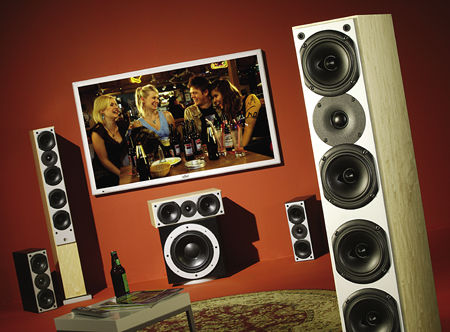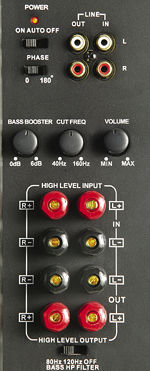System Audio SA1750 Speaker System
In 1984, Ole Witthoft found the state of the speaker art wanting. To his ears, most speakers suffered in two fundamentally intertwined ways: One, they didn't present the details of sound in a way that, two, led you to sense the music's feeling and passion. So, like so many entrepreneurs who try to fill the void in a marketplace based on their own perceptions, Witthoft launched System Audio, using these composite criteria as his mission statement.

As owner and chief R&D engineer, Witthoft has produced numerous visually simple yet musically elegant designs, establishing the company as one of Denmark's serious players in the European arena. Not enough American video- and audiophiles know of this company and its eargasmic successes. I've decided to correct America's lack of awareness by shedding some light on a possible 5.1 System Audio configuration.
Nuts and Bolts
The core of most System Audio speakers is a mid-tweeter-mid 2.5-way design, augmented in my review system by a fourth-order Linkwitz/Riley crossover that includes a delay on the tweeters for "virtually placing them in line with the bass/mid drivers," according to Witthoft. This approach, he notes, creates an "acoustically optimized phase response, leading to stable imaging and cleaner midrange." System Audio has positioned the crossover on a removable plastic recess, the other side of which sprouts five-way binding posts. Additionally, each woofer/midrange driver sports a phase plug that acts like a heatsink, allowing the driver magnets to operate coolly and efficiently under the prolonged load requirements that a soundtrack can generate.
 All of the drivers are sourced from Vifa/Scanspeak, which adapts them to Witthoft's specs. The woofers consist of treated-paper membranes, while the 1-inch tweeter is made of coated fabric, not the metal dome material more common in many of today's home theater lines. To minimize diffraction effects and better control resonance, the drivers are planted in a separate baffle that's attached to the front of the speaker cabinet. The baffle is slightly narrower than the CD-wide speaker front. All of these choices allow the precious midrange to be one of the system's hallmarks. Add transparency and a matched timbre around the soundfield, and you get enough detail married to feeling and passion to make you devote more time to the television.
All of the drivers are sourced from Vifa/Scanspeak, which adapts them to Witthoft's specs. The woofers consist of treated-paper membranes, while the 1-inch tweeter is made of coated fabric, not the metal dome material more common in many of today's home theater lines. To minimize diffraction effects and better control resonance, the drivers are planted in a separate baffle that's attached to the front of the speaker cabinet. The baffle is slightly narrower than the CD-wide speaker front. All of these choices allow the precious midrange to be one of the system's hallmarks. Add transparency and a matched timbre around the soundfield, and you get enough detail married to feeling and passion to make you devote more time to the television.
Relatively light at 44 pounds, the SA1750 tower sports an additional pair of woofers below the mid-tweeter-mid array and two ports on the rear. This allows the left and right channels to drop down to a claimed, not-insignificant 40 cycles, roughly equivalent to the sound of the lowest note plucked on an upright bass. In stereo mode, the SA1750s showed their bottom end control (no overhang was noticeable) on "Show Biz Kids," a bass-heavy track from Rickie Lee Jones' It's Like This.
The SA720AV center channel really seduces with its pair of 5-inch woofers, seemingly optimized to present a large envelope of midrange magic. Not once did I wonder, "What did he just say?" during the course of a movie. Unlike the front spread, the surround channels don't offer biwire capability, but that doesn't take away from their abilities. Film after film, the fill of information between the front and rear sounded seamless, even though the signals had to travel through 50 feet of speaker wire per channel.
Although modestly sized, the SE200 subwoofer delivers on par with the rest of the system. One might think that a 10-inch sub couldn't possibly stand up to modern films' SPL and precision demands, but that's not the case. The box boasts a 380-watt (peak) amplifier driving a very long-stroke motor system. To control cabinet resonance, nearly 1-inch-thick finished MDF comprises the walls, while the front and bottom are reinforced with an additional 1.3 and 1.9 inches of MDF, respectively. Further, you can optimize the sub for your listening environment's acoustic demands: The circular plinth can be unscrewed and moved to configure the SE200 into a vented or sealed-box speaker. Running the speaker in closed mode produced greater tightness and less boom.
Although the SA1750 tower rides on an ample silver-painted MDF plinth, it is top heavy. The speaker's base provides you with a space for sand, and I suggest you utilize this option to enhance stability. Furthermore, the recessed binding-post cup is made of plastic (for the price of the system, this seems to be too penny-wise), and the binding posts' positions don't readily allow for use of spade connectors.
Why the Europeans Have Gone Ga-Ga
I drove the system with Lexicon's RT-10 disc player, Parasound's Halo C 1 processor, and the modestly power-hungry but still killer Marantz SR-96 receiver. I lashed everything together with Nordost Optix-OX2 Super S-video cable, Valkyrya interconnects, Valkyrya biwire speaker cable (front and center), and Red Dawn speaker cable (surrounds).
The System Audio setup's single most overwhelming characteristic is that it has a midrange presence to die for. Perhaps the mids are intentionally boosted a bit; to my thinking for videophile purposes, this serves the greater good—awareness of mood and feeling, not mere effects, is the result. Thanks to the center channel's 5-inch drivers, voices revealed a powerful sense of their emotional content—dialogue became expressive. The nuance of meaning and feeling, language's subtle shadings, leapt out and grabbed me. In The Fellowship of the Ring, Frodo sounded clearly youthful with an innocent earnestness, while Gandalf's voice suggested the wisdom of the ages. That's how close the SA720AV brings you to sensing emotional content in sound, and it goes a long way toward explaining why I spent so much time viewing films and television.
I can say the same of music. Violins, even in the background, suddenly displayed appropriate woodiness, kettle drums their resonant interiors, and brass instruments their biting blattiness without sounding hard or congealed. The ensemble exposed the textures of instruments and instrumental lines.
Spittiness and sibilance, while not completely eliminated, don't draw attention to themselves. Perhaps because the tweeters are built of fabric, one gets more than enough detail without a harsh sound. Granted, many of today's 5.1 systems prefer to emphasize high frequencies to get your attention in the A/V store. While this may be useful in reproducing gunfire shells landing on a concrete floor or ricocheting off a brick wall, the hyper-emphasis of high frequencies can grate on the nerves over the long haul; it does nothing to allow well-done sound design to establish the tone of a scene—like the delicacy of audio detail found in the introduction to the Shire at the beginning of The Fellowship of the Ring. Through the System Audio ensemble, the birds' chirps filled the spaces high overhead, even between the front and surround channels, as the wheels of Gandalf's cart crushed the gravel while it moved from left to right front. The timbre of the crushed stone maintained a continuity of tone without waiver as the cart proceeded. The sounds' richness added to the scene's idyllic tone, and that's damned magical to my sensibilities.
Whether it was DVD or my cable system's Dolby Surround, the front three channels delivered a wide, deep soundstage, positioning elements precisely. When I added the subwoofer and surrounds, I achieved nothing short of immersion. This system also delivers in the large-scale dynamics department. Gladiator's opening battle scenes were loud and powerful, yet the soundfield didn't congeal or morph into an indistinct mass. From massed strings to the clang of sword upon sword to the clarity of dialogue amidst the din, everything retained its place and maintained an appropriateness of nuance. Again, compelling magic.
I could easily go on and on, but I'd only repeat myself. This system, when coupled with the right electronics, will enhance your ability to suspend disbelief. In addition to the visceral core, the SA system will give you nothing less than the emotional core. We should all consider ourselves lucky that Witthoft perceived what he did more than 20 years ago and grew determined to build a better product.
Highlights
• User configurable bass: vented or sealed box
• Clean, post-modern Danish styling that integrates well with silver-finished electronics
• Seductive midrange, especially with films
























































